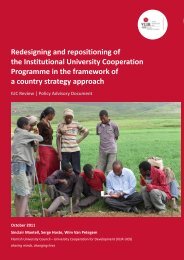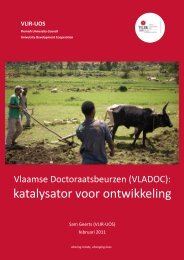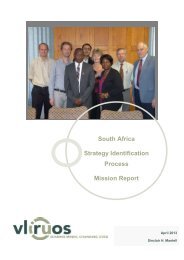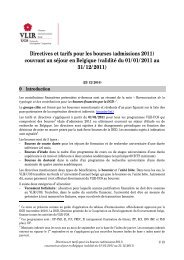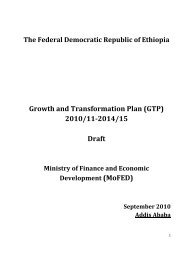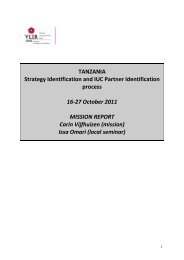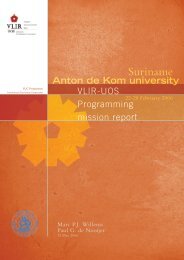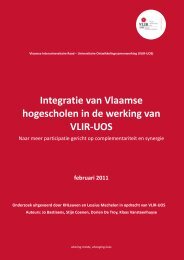Education Sector Development Program - VLIR-UOS
Education Sector Development Program - VLIR-UOS
Education Sector Development Program - VLIR-UOS
Create successful ePaper yourself
Turn your PDF publications into a flip-book with our unique Google optimized e-Paper software.
<strong>Education</strong> <strong>Sector</strong> <strong>Development</strong> <strong>Program</strong> IV<br />
Joint Review Missions and Annual Review<br />
Meetings with stakeholders<br />
At the third level, Joint (government-donors)<br />
Review Missions (JRM) will be conducted each<br />
year prior to the Annual Review Meetings. JRMs<br />
will concentrate on selected issues for review<br />
decided by the Technical Task Force, a committee<br />
consisting of Government and development<br />
partners. JRMs may be also informed by studies<br />
and research to assess the progress in outcomes<br />
as stipulated under ESDP IV.<br />
The Secretariat of the SMSC (Process of Resource<br />
Mobilization and Planning) will prepare a<br />
consolidated annual performance report on<br />
the basis of the half-yearly and annual reports<br />
prepared by the implementing units at both the<br />
MOE and REBs as well as other additional inputs<br />
(such as JRM reports, evaluative studies and<br />
financial reports).<br />
These reports serve as the basic document for<br />
the Annual Review Meeting with stakeholders.<br />
The ARM will offer the opportunity to assess<br />
achievements and shortcomings of the plan<br />
implementation and to agree on improvements<br />
in order to reach the development objectives and<br />
targets put forward by ESDP IV. Each ARM will be<br />
timed in such a way that it can serve as a basis<br />
for preparing the Annual Operational Plan and the<br />
budget of the following year.<br />
Mid-Term and Final evaluation<br />
ESPD III has put major emphasis on monitoring<br />
of key performance indicators, primarily related<br />
to inputs, but less so on formative and summative<br />
evaluation. Under ESDP IV, there will be a midterm<br />
evaluation conducted in the course of<br />
2012/13 and presented at one of the ARMs. This<br />
is intended to examine more carefully results<br />
obtained and problems encountered and to decide<br />
whether there is need for revision of the targets<br />
and programs foreseen for the second term of<br />
ESDP IV. In addition to the internally produced<br />
performance reports, the Resource Mobilization<br />
and Planning Process will carry out special<br />
evaluative studies to assess more systematically<br />
programs with innovative components, with a<br />
view of deriving lessons from these studies for<br />
further planning and program development.<br />
A final evaluation of a summative nature will be<br />
conducted at the end of ESDP IV in order to draw<br />
comprehensive lessons for ESDP V. Selected<br />
evaluative studies will be undertaken prior to<br />
it and a final performance report prepared in<br />
2014/15 E.C. to look back at the plan as a whole.<br />
The final performance report will be presented at<br />
a Final Review Meeting with stakeholders in order<br />
to evaluate final outcomes, their relevance, costeffectiveness<br />
and sustainability. This meeting will<br />
also analyze the reasons why certain results have<br />
been achieved and not others and derive lesson<br />
for possible policy revision and for preparing the<br />
next education sector plan.<br />
Key performance indicators<br />
A set of key performance indicators will be used to<br />
allow monitoring of the main program outcomes<br />
as stipulated under ESDP IV. These indicators are<br />
directly derived from the targets put forward in<br />
the program matrices. They have been commonly<br />
agreed upon by the stakeholders of ESDP IV, i.e.<br />
the government tiers (MOE, REBs, WEOs), the<br />
community and the development partners.<br />
To improve the reliability of data, ESDP IV<br />
suggests to further strengthen the EMIS system,<br />
in particular at decentralized levels. This is, of<br />
course, one of the preconditions for a strengthening<br />
of decentralized planning capacities.<br />
The following list presents the key indicators<br />
for ESDP IV. This list includes indicators which<br />
already were identified under ESDP III (to allow<br />
for a continued monitoring) and some new<br />
indicators of particular relevance for monitoring<br />
the main objectives of ESDP IV.<br />
The program matrices in ESDP IV propose many<br />
indicators and targets, to monitor the progress<br />
made with the achievement of the expected<br />
outcomes and the implementation of the proposed<br />
programs and activities. This should be treated<br />
with care: not all information can be collected at<br />
this stage. The personnel and resources needed<br />
to collect all this information at a nation-wide<br />
level may not be available. We have nevertheless<br />
opted to mention these indicators as they can<br />
guide future data collection exercises. They<br />
are meant to focus all stakeholders involved in<br />
ESDP IV implementation, on what are considered<br />
to be key points and thus steer their work towards<br />
the ESDP IV objectives.<br />
Before undertaking new data collection<br />
exercises, it is useful to check if for some<br />
indicators, information is already being collected<br />
by various departments as part of their normal<br />
administrative and reporting procedures. In<br />
many cases, information is available, but is not<br />
yet analyzed at present and no indicators are<br />
available. In other cases, the information is not<br />
yet being collected. It is suggested that, during<br />
the implementation of ESDP IV, the already<br />
available data will be analyzed and, where<br />
necessary, additional data will be collected; this<br />
can then form the basis to define a target. The<br />
collection of new data may not always need to<br />
cover the whole country but could proceed for<br />
certain data, on a sample basis.<br />
93




